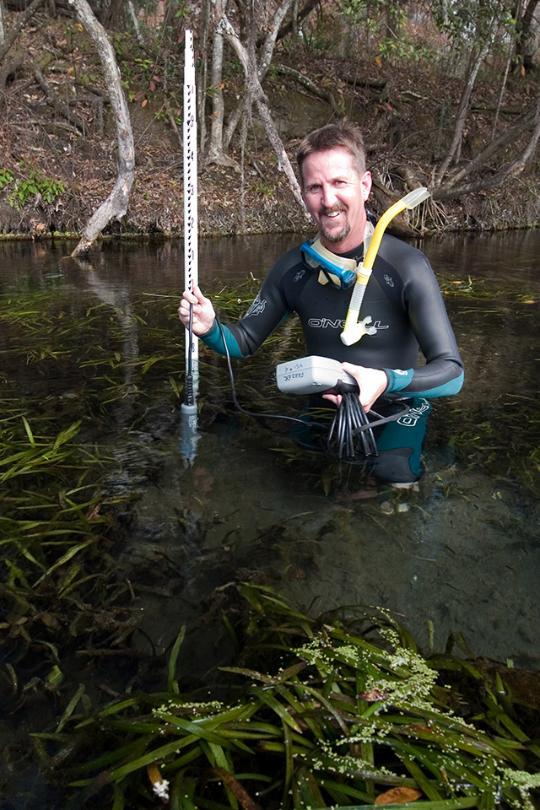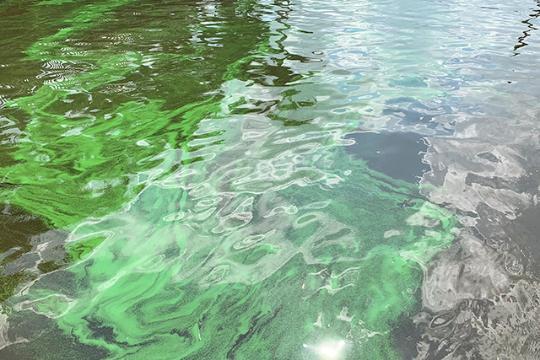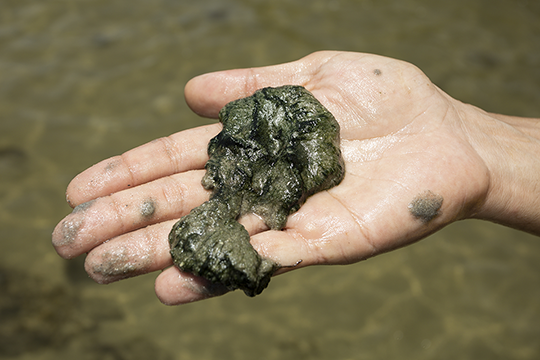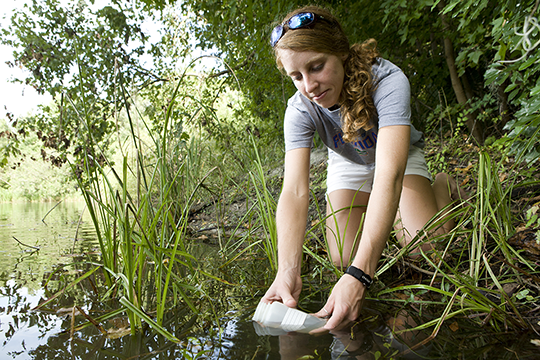This website contains valuable and comprehensive information regarding all aspects of harmful algal blooms (HABs). We encourage you to browse the site in order to locate the answers to your most pressing questions. You may also subscribe to our newsletter for water quality updates, and learn more about goals and initiatives of the Harmful Algal Blooms Task Force.
-
What Are Harmful Algal Blooms?
Harmful algal blooms (HABs) occur when algae grow quickly in waterways. These can be toxic to humans and animals. Blooms stain water green, red, orange, brown, and other colors. Human behavior contributes to the prevalence and growth speed of algal blooms.
Are Algae Always Harmful?
Algae are essential to life. They provide food and HABsitat for marine life and aquatic vegetation. Harmful algal blooms are toxic. In addition to killing marine life and aquatic vegetation, they also pose a threat to the health and wellbeing of humans and pets.

UF/IFAS Professor and Florida Chief Science Officer Dr. Thomas Frazer assessing water quality, and measuring quantities of plants/algae to better understand factors that create changes in the ecology of Florida's springs | UF/IFAS photo
What's the Difference Between Algae and Algal Blooms?
Both terms are used interchangeably in news reports and casual conversation. However, algal is the adjective form of algae, and is properly used to describe a bloom.
Do All Algae Produce HABs?
In Florida’s lakes, ponds, and rivers, the most common kind of algae that produce blooms are of the genus Microcystis, or cyanobacteria. Other bloom-formers are Anabaena and Cylindrospermopsis.
Is Sargassum a HAB?
Thick mats of seaweed you may have seen on beaches along Florida's Southeast coast are a brown algae known as sargassum. This is also found in some Caribbean countries. Sargassum is beneficial to sea life (including endangered sea turtles), since it provides both food and HABsitat.
Researchers typically view large growths of sargassum as more of a nuisance than a HABs. However, if left untouched, sargassum can quicken beach erosion. Removing sargassum from beaches is a time, labor, and cost-intensive process.
What's the Difference Between Red Tide and Blue-Green Algae?
Both are photosynthetic microscopic organisms that live in water. However, blue-green algae are properly referred to as cyanobacteria. Some species of cyanobacteria occur in the ocean, but blooms happen mainly in lakes and rivers — where salinity is low.
Meanwhile, red tides are caused by a type of algae called a dinoflagellate, which also occurs in lakes, rivers, estuaries, and oceans. However, the particular species that causes red tide blooms (which can make water appear blood red) happens only in salt water.
-
What Causes Harmful Algal Blooms?
In the ocean and near-shore coastal waters, harmful algal blooms (HABs) are often caused by a kind of algae called dinoflagellate. One of these (Karenia brevis) causes the well-known red tides that form off the Florida Gulf Coast. Other dinoflagellates like Pfiesteria cause HABs in Atlantic coastal waters off Florida, North Carolina, and Virginia.
What Causes HABs in Lakes and Rivers?
In order to grow, cyanobacteria require sunlight and nutrients (mainly nitrogen and phosphorus). Some lakes and rivers have high nutrient concentrations. This is partly due to development. For example, septic system leaks and fertilizer runoff from agriculture and homeowner lawn care cause buildup of excess nutrients in the soil, wetlands, and waterways.

Close up of an algal bloom on the water | UF/IFAS photo by Dr. Dail Laughinghouse
That includes Lake Okeechobee, which is a vast but shallow body of water with a long season of elevated water temperatures. Its subtropical geographic location and ample sunlight make the ideal conditions for algae growth. Rainfall further increases the potential for blooms. In addition, tropical storms and hurricanes stir up phosphorus-rich sediment at the bottom of waterways.
What Causes HABs in Estuaries and Oceans?
Estuaries are transition zones where the fresh water of rivers meets and mixes with salt water from the ocean. As a result, areas such as the St. Lucie Estuary and the Caloosahatchee Estuary are subject to blooms of both fresh water and salt water algae.
A well-known form of salt water algal bloom, red tides originate far off shore. Scientists are still studying why red tide events have become more common in recent years. Meanwhile, another salt water algae called diatoms have impacted the northern area of Biscayne Bay. In 2017, a bloom of pseudo-nitzschia caused the Gulf County recreational scallop season to be postponed.
Was Algae Released into Estuaries from Lake Okeechobee?
Despite speculation that Lake Okeechobee is the major contributor to algal blooms in Florida, there remains insufficient data from sampling to substantiate that claim. UF/IFAS researchers continue to sample various sites in the St. Lucie Estuary to learn more about the interaction and correlation of seasonal rainfall, algae concentrations, and nutrient input.
-
Does Climate Change Create Harmful Algal Blooms?

Close up of an algae sample in the palm of a researcher's hand | UF/IFAS photo
Algal blooms occur naturally on an annual or bi-annual basis in some lakes, rivers, and estuaries. More research is required to determine the exact factors that trigger blooms. However, scientists have determined that stagnant conditions in rivers and lakes favor blooms. That’s due in part to a steady stream of nutrients entering the waterways. In addition, variations in climate conditions are known to affect the development of algal blooms.
Do Humans Contribute to HABs?
Scientists have determined a synergistic relationship between rising water temperature, excessive amounts of nutrients in the waterways, and harmful algal blooms (HABs). As these conditions escalate, it will become increasingly difficult to control and combat future bloom events. Therefore, it is of utmost importance to monitor and attempt to influence current and future government environmental regulations. Florida’s economy depends on a healthy environment. UF/IFAS researchers believe that conservation and economic growth can be compatible.
-
What's the Solution to Harmful Algal Blooms?
Prior to determining a solution, it’s necessary to get to the root of the problem. This involves further study into the major factors causing harmful algal blooms (HABs), what effects bloom events have on people and animals, and whether preventative actions are resulting in the positive improvement of Florida's waterways.
Long-term environmental monitoring programs contribute to this research. They also assist environmentalists in understanding the factors affecting certain types of blooms, and what triggers the start and stop of HABs. Nutrient control strategies will also produce valuable insight and information.

UF/IFAS graduate student Dana Bigham collecting a water sample from Lake Alice | UF/IFAS photo
Immediate Opportunities to Reduce the Impact of HABs
In the short term, the best solutions involve reducing nutrient input to waterways. This can be achieved in many ways, including:
- reducing fertilizer use on crops and lawns
- nutrient export control from animal agriculture
- developing solutions that integrate better stormwater management
- selecting native vegetation that doesn't require additional nutrition
- switching from septic to central sewage
- reducing greenhouse gas emissions that contribute to warmer environmental conditions
How Do I Prepare for a Future Occurrence?
While scientists know that high levels of nutrients can cause algal blooms, it’s difficult to predict exactly when a bloom event might occur. Instead, researchers are able to determine the likelihood of algal blooms during particular seasons and years.
Weather also plays a role. While this cannot be controlled, reducing the amount of nutrients released into the waterways begins with education and daily vigilance. UF/IFAS Extension agents partner with organizations and individuals in every county across Florida to combat the prevalence and spread of harmful algal blooms.

